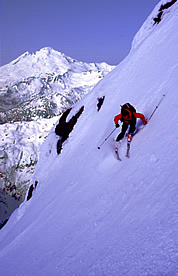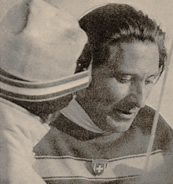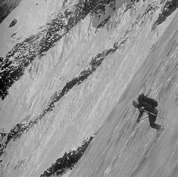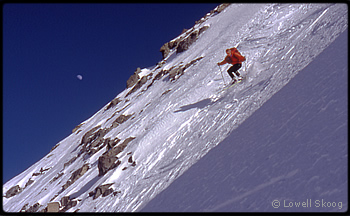 |
 ki
mountaineering has a history as rich as that of alpine climbing but much
less well documented. As climbing in the Northwest has mirrored development
in other ranges—with advancements in equipment, techniques and ambition—so
too has ski mountaineering. During the past twenty-five years, ski mountaineering
in the Cascades has entered a phase that began earlier in the Alps and has
spread to other North American regions. Skiers are pursuing steep, technical
descents, often on classic mountaineering routes, where judgment of terrain
and snow conditions is critical and the consequences of a fall can be as
serious as in climbing. ki
mountaineering has a history as rich as that of alpine climbing but much
less well documented. As climbing in the Northwest has mirrored development
in other ranges—with advancements in equipment, techniques and ambition—so
too has ski mountaineering. During the past twenty-five years, ski mountaineering
in the Cascades has entered a phase that began earlier in the Alps and has
spread to other North American regions. Skiers are pursuing steep, technical
descents, often on classic mountaineering routes, where judgment of terrain
and snow conditions is critical and the consequences of a fall can be as
serious as in climbing.
 |
 |
|
Ski descent of the Mt. Shuksan summit pyramid. Enlarge
© Lowell Skoog. |
|
 |
Slowly at first, Cascade skiers dabbled in steeper terrain—intermittently,
cautiously, and in isolation from each other. But in the last decade, due
to better equipment, changing attitudes, greater communication, and a new
generation of skiers, the floodgates have burst open. In the past seven years,
more new steep descents have been made in the Washington Cascades than in
the previous twenty. Northwest ski mountaineering has passed through several
stages—from infancy to the conquest of the volcanic peaks in the 1930s
and 1940s; consolidation and the scouting of wilderness summits in 1950s
and 1960s; resurgence and the pioneering of remote high routes in the 1970s
and 1980s. Since the mid-1990s, we have entered a period of unprecedented
growth in the number of skiers and a Golden Age of pioneering steep ski descents.
This article will trace the development of Cascade steep skiing from the
earliest days through 2003. Since many of the descents I’ll mention
have never been recorded before, and since I’m continuing my research
with the goal of writing a book on the first century of Cascade ski mountaineering,
I hope this article will help bring other reports to light.
Records of ski mountaineering in the Cascades are sketchier than those of
climbing. It is possible that on just the right day, with just the right
conditions, early skiers made some remarkable descents that were never recorded.
A few surviving accounts hint at the possibilities. In 1931, Hjalmar Hvam,
Andre Roch and Arne Stene made the first ski ascent of Mt. Hood. Whether
they skied from the actual summit is unknown, and authorities such as Lou
Dawson in his book Wild Snow doubt it. Yet if anyone could have
skied from the top in those days it was these men. Hjalmar Hvam was the Silver
Skis
champion on Mt. Rainier in 1936. During the same year, he entered the Washington
Ski Club’s four-way competition at Mt. Baker—cross-country, slalom,
downhill, and jumping—and won every event. Andre Roch became one of
the most accomplished climbers and ski mountaineers of the twentieth century,
best known for his Swiss avalanche work and for pioneering the route to the
South Col of Mt. Everest in 1952, a year before the successful climb by Hillary
and Tenzing.
In 1933, Paul Gilbreath and J. Wendell Trosper skied up and down Little Tahoma,
using skis to within eight feet of the top. In The Challenge of Rainier,
Dee Molenaar wrote (with considerable understatement) that this was “a
delicate feat considering the high angle of the upper several hundred feet
of the peak.” 1933 was a big snow year in the Cascades and these men
were just the sort required for such a feat. Gilbreath later became a two-time
winner of the Silver Skis race. Trosper, in addition to being a Silver Skis
competitor, was the first man to climb Mt. Rainier by ten different routes.
First-rate skiers and climbers pursued ski mountaineering in those early
years, and these ascents on Mt. Hood and Little Tahoma suggest that they
may have accomplished more than we commonly give them credit for.
 |
 |
|
Sylvain Saudan relaxes following his descent of the Newton Clark Headwall on Mt. Hood in March, 1971. © Mel
Olmstead. |
|
 |
Without dismissing the potential achievements of the early skiers, we
can pinpoint the beginning of the modern era of steep descents in the
Cascades precisely. On March 1, 1971, Swiss mountaineer Sylvain Saudan
skied from the summit of Mt. Hood by the Newton Clark Headwall.
Saudan was the best-known of the Europeans developing the sport of
“extreme skiing,” descending classic snow and ice climbing
routes in the Alps on skis. Saudan promoted himself as “The
Skier of the Impossible” and was famous for one of his training
methods—skiing down talus slopes without the benefit of snow.
Starting in 1967, he had made a half-dozen major descents in the Alps,
including the Gervasutti Couloir on Mont Blanc and the west face of the
Eiger. He came to Mt. Hood expressly to make the first descent of its
kind in North America.
Saudan’s attempt was delayed by illness and a blizzard that dumped
five feet of snow on the mountain. Waiting at Mt. Hood Meadows for two weeks,
he studied potential routes on the peak on a topographic map. When the weather
cleared he was whisked by helicopter to the summit and completed his descent,
which was covered prominently by the Northwest skiing press. Saudan’s
feat preceded by three months the more widely publicized ski descent by Bill
Briggs of the Grand Teton in Wyoming. Yet, neither descent was really the
first of its kind in North America. That distinction belongs to Brooks Dodge,
who during the late 1940s and early 1950s pioneered a dozen ski descents
in Tuckerman Ravine, New Hampshire, including gullies that exceeded 50 degrees.
Dodge’s achievements were generally unknown outside of New England.
Three years after Saudan’s visit, a young local skier, Brian Raasch,
repeated the Newton Clark descent. But the seed planted by Saudan lay dormant
for almost a decade before it began to take root. In May, 1980, Dan Davis,
a veteran Northwest climber who had made first ascents of the north face
of Mt. Robson in Canada and the north peak of Mt. Index in the Cascades in
winter, skied from the summit of Mt. Rainier to the Nisqually River bridge
via the Fuhrer Finger. Davis was accompanied by Tom Janisch and Jeff Haley,
who also skied the Finger, starting somewhat below the summit. This, the
first new ski route on Rainier in almost two decades, went unreported for
years. But as Davis and friends were quietly returning to Seattle, on the
other side of the mountain two men were approaching Rainier with even bigger
plans.
Chris Landry, of Aspen, Colorado, and Doug Robinson, of Bishop, California,
had met earlier that spring at an outdoor industry trade show in Las Vegas.
There they hatched the idea for their expedition and lined up a few sponsors.
They approached Mt. Rainier hauling a sled and 200 pounds of gear, including
two pairs of boots each and two pairs of downhill skis for Landry. On May
6, they warmed up by skiing the Emmons Glacier, with Robinson making what
he believed to be first ski descent of Rainier on three-pin bindings. Then
they circled the mountain to the north, waiting out a blizzard for several
days. On May 12, they climbed Liberty Ridge, the classic north-side route
on Rainier, and Landry completed its first ski descent. Robinson descended
the route on foot to take photos.
 |
 |
|
Chris Landry skis the upper slopes of Liberty
Ridge on Mt. Rainier in May 1980. © Doug Robinson. |
|
 |
Landry described Liberty Ridge as “definitely the finest descent I’ve
ever done and well worth the two years of preparation.” Remarkably,
the descent was repeated just three years later by visiting skiers Tom Carr
and Eric Hendren using telemark ski gear. Most skiers who considered descending
such routes felt, as Landry did, that alpine ski gear was essential. Landry
descended Liberty Ridge on Rossignol FP downhill skis carefully sharpened
and hauled up the mountain “taped together with a paper spacer, only
taking them out the morning of the descent.” His skis were mounted
with Marker M5 bindings set to “Race” and he switched from climbing
boots to alpine ski boots before starting down. Alpine touring equipment
in the 1980s was poorly suited for such descents (telemark gear was even
more poorly suited) and few skiers were motivated to work as hard as Landry
had, carrying all the extra gear, to make subsequent descents.
|
 |
| Chronology
before 1990 |
| |
|
A different era is presented on each page of this article. Not every
descent listed is “steep” and not every steep descent is
listed. These are selected noteworthy routes. Except for the Newton
Clark Headwall, no Mt Hood descents are listed here, due to
incomplete research. Routes mentioned in the accompanying article
are indicated with an asterisk. |
|
 |
• 1971, March 1
Mt Hood, Newton Clark Headwall
Sylvain Saudan* |
 |
• 1979, April 28
Mt Stuart,
Cascadian Couloir
Eric and Kurt Feigl |
 |
• 1980, May 3
Mt Rainier, Fuhrer
Finger
Dan Davis, Jeff Haley, Tom Janisch* |
 |
• 1980, May 12
Mt Rainier, Liberty
Ridge
Chris
Landry* |
 |
• 1981, March 1
Mt Shuksan, North
Face
Jens Kieler, Gordy Skoog* |
 |
• 1981, April 19
Eldorado Peak, True
Summit
Jens Kieler, John Mueller, John Waldrop, Gordy Welsh, Craig
Wicklund* |
 |
• 1983, April 16
Del Campo Peak,
North Face
Jens Kieler* |
 |
• 1985, March 13
Whitehorse Mountain,
NW Glacier
Jens Kieler* |
 |
• 1985, spring
Robinson Mountain, East
Cirque
Sprague Ackley, Hope Barnes* |
 |
• 1985 (circa)
Cannon Mountain, NE Couloir
Gordon
Briody, Rob Harris |
 |
• 1985, May 19
Mt Fury, SE Glacier
Jens
Kieler, Carl and Lowell Skoog* |
 |
• 1985, spring
Mt Rainier, Kautz
Glacier
Dale Farnham* |
 |
• 1987 (circa), spring
Mt Shuksan, Summit
Pyramid
Steve Vanpatten, Jim Witte* |
 |
• 1988, spring
Mt Rainier, Gibraltar Chute
Dale
Farnham* |
 |
• 1989, March
Oval Peak, North Couloir
Sprague
Ackley, Hope Barnes* |
|
 |
| Correction
|
 |
|
The original version of this article wrongly stated that
Sylvain Saudan's 1971 Mt. Hood descent was of the Wy’east
Route. A more careful review of sources indicates that he skied
the Newton Clark Headwall. The article has been corrected.
|
| |
|
 |



